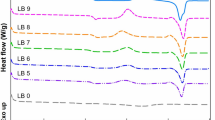Abstract
Poly-l-lactide (PLLA) is a widely used sustainable and biodegradable alternative to replace synthetic plastic materials in the packaging industry. Unfortunately, its processing properties are not always optimal, e.g. insufficient melt strength at higher temperatures needed in extrusion coating processes is recognized. In the present work, one have addressed the problem by peroxide modification of commercial PLLA in order to obtain chain branching. Reactive extrusion of PLLA has been carried out in the presence of 0.1, 0.3 and 0.5 wt% of various peroxides [tert-butyl-peroxybenzoate, 2,5-dimethyl-2,5-(tert-butylperoxy)-hexane (Lupersol 101) and benzoyl peroxide]. The peroxides were chosen due to their different decomposition rates at a reactive extrusion temperature of 190 °C. Changes in thermal properties (differential scanning calorimeter) and dynamic rheology, where studied. The rheological analyses were conducted at 240 °C as to mimic typical PLLA extrusion coating conditions. The peroxide-treated PLLAs showed increased complex viscosity and storage modulus at lower frequencies indicating the formation of branched/cross linked architectures. The branching is also supported by the size exclusion chromatography-chromatogram signals revealing the development of higher molecular weight species. The material property changes were dependent on the peroxide and the used peroxide concentration. Gel fraction analysis showed that the peroxides afforded different gel contents and especially 0.5 wt% peroxide produces both an extremely high molar mass and a cross linked structure, not perhaps well suited e.g., for further use in a blending step. The thermal behavior was somewhat unexpected as the materials prepared with 0.5 wt% peroxide showed the highest ability for crystallization and cold crystallization despite substantial cross linking.






Similar content being viewed by others
References
Rhim J, Ng PKW (2007) Crit Rev Food Sci Nutr 47:411–433
Hartmann M, Whiteman N (2000) In polylactide, a new thermoplastic for extrusion coating, vol 1. TAPPI Press, Atlanta, pp 467–474
Lahtinen K, Maydannik P, Johansson P, Kääriäinen T, Cameron DC, Kuusipalo J (2011) Surf Coat Technol 205:3916–3922
Ryan CM, Hartmann MH (1997) In Branching of poly(lactic acid) to increase melt strength for extrusion coating, vol 1. TAPPI Press, Atlanta, pp 139–144
Kang GB, Kim MH, Son Y, Park OO (2009) J Appl Polym Sci 111:3121–3127
Toft N, Rigdahl M (2002) Int Polym Process 17:244–253
Lachtermacher MG, Rudin A (1995) J Appl Polym Sci 58:2077–2094
Ouchi T, Ichimura S, Ohya Y (2006) Polymer 47:429–434
Korhonen H, Helminen A, Seppälä JV (2001) Polymer 42:7541–7549
Liu J, Lou L, Yu W, Liao R, Li R, Zhou C (2010) Polymer 51:5186–5197
Soedergaard A, Niemi M, Selin J, Naesman JH (1995) Ind Eng Chem Res 34:1203–1207
Carlson D, Dubois P, Nie L, Narayan R (1998) Polym Eng Sci 38:311–321
Takamura M, Nakamura T, Takahashi T, Koyama K (2008) Polym Degrad Stab 93:1909–1916
Dean KM, Petinakis E, Meure S, Yu L, Chryss A (2012) J Polym Environ 20:741–747
Sungsanit K, Kao N, Bhattacharya S, Pivsaart S (2010) Korea Aust Rheol J 22:187–195
Dorgan JR, Lehermeier H, Mang M (2000) J Polym Environ 8:1
Liu J, Yu W, Zhou C (2011) J Rheol 55:545–570
Takamura M, Nakamura T, Kawaguchi S, Takahashi T, Koyama K (2010) Polym J 42:600–608
Soedergard A, Naesman JH (1994) Polym Degrad Stab 46:25–30
Takamura M, Sugimoto M, Kawaguchi S, Takahash T, Koyama K (2012) J Appl Polym Sci 123:1468–1478
Ramos VD, da Costa HM, Pereira AO, Rocha MCG, de S. Gomes A (2004) Polym Test 23:949–955
Zulli F, Andreozzi L, Passaglia E, Augier S, Giordano M (2013) J Appl Polym Sci 127:1423–1432
Wu D, Wu L, Zhang M, Zhao Y (2008) Polym Degrad Stab 93:1577–1584
Schulze D, Roths T, Friedrich C (2005) Rheol Acta 44:485–494
Acknowledgments
The authors wish to thank the Finnish Funding Agency for Technology and Innovation (TEKES) for financial support. We also wish to extend our sincere appreciation to Stora Enso Oyj.
Author information
Authors and Affiliations
Corresponding author
Rights and permissions
About this article
Cite this article
Khajeheian, M.B., Rosling, A. Rheological and Thermal Properties of Peroxide-Modified Poly(l-lactide)s for Blending Purposes. J Polym Environ 23, 62–71 (2015). https://doi.org/10.1007/s10924-014-0693-4
Published:
Issue Date:
DOI: https://doi.org/10.1007/s10924-014-0693-4




